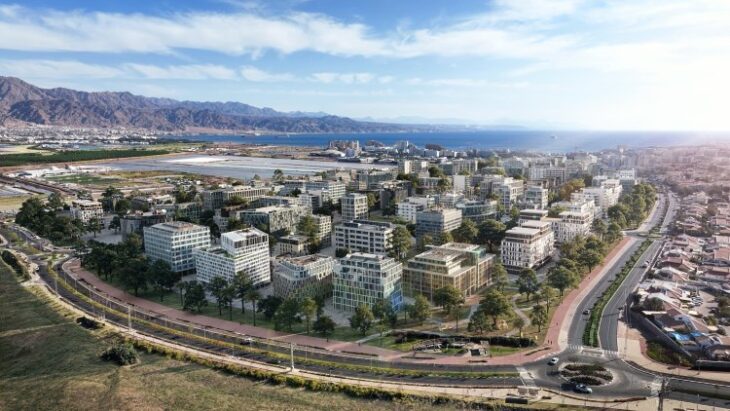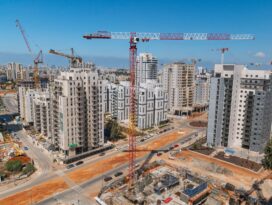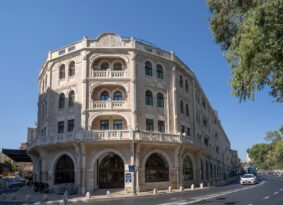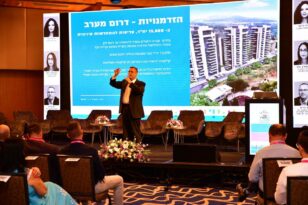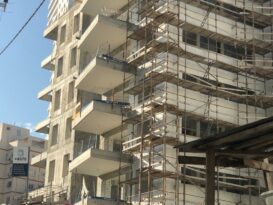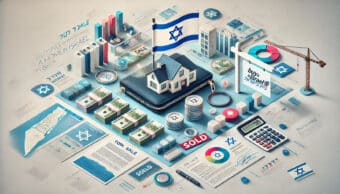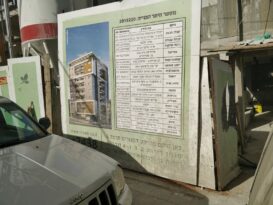How does an old industrial zone become a city’s growth engine? A bold urban renewal plan in Eilat is transforming 735 dunams of outdated industrial land into a vibrant urban district, offering developers up to 600% more in building rights. The Open Quarter project combines housing, tourism, commerce, and employment in a flexible, mixed-use model aimed at revitalizing the city’s economy and attracting new residents. More than just a real estate project, it represents a new vision for urban renewal in Eilat and Israel’s south.
While most Israeli cities struggle over every square meter of land for development, an urban renewal project in Eilat is introducing a bold new model: transforming a 735-dunam old industrial zone into a vibrant urban hub, with an unprecedented 600% increase in building rights. This dramatic change not only reshapes the city’s landscape but presents a rare opportunity for developers and investors.
The Open Quarter, as it’s called, reflects a fundamental shift in urban planning. Instead of a traditional industrial area made up of garages and workshops, an innovative mixed-use space is emerging—one that blends housing, hospitality, commerce, and employment. The plan, which has already attracted national attention, allows developers exceptional flexibility, even permitting open usage of their building allowances.
Located at Eilat’s northern entrance, bordered by the former airport grounds to the east and older neighborhoods to the west, the area already plays a key economic role in the city. The new plan, however, promises to take it even further—literally, several stories higher. “We’re not just renovating buildings,” emphasizes attorney Moran Harel, Director of the Industrial and Employment Zones Division at the Eilat Economic Company (EEC), the municipal authority overseeing the project. “We’re creating an entirely new urban fabric that will transform this area into a lively urban center.”
Last month, the plan won a prestigious award from the Israel Planners Association for its innovative and unique approach. The judging panel cited the plan’s dynamic and flexible model for regional renewal, integrating open uses, interactive decision-making tools, and urban connections that strengthen the local economy.
Challenges and Solutions
According to Harel, Eilat faces significant challenges, primarily due to its geographic isolation. It’s a city that depends almost entirely on tourism, making its economy highly vulnerable. The closure of Sde Dov airport and relocation of the airport farther from the city have seriously impacted accessibility, and the absence of infrastructure like a railway only deepens the issue. One of the biggest challenges is employment: large companies avoid establishing a presence in Eilat due to its remoteness, making it hard for the city to attract young, skilled populations.
The Open Quarter project aims to address several of these issues. “Our vision,” says Harel, “is to reverse the trend and strengthen quality employment in the city. While the plan allows for a wide range of uses, we’re ensuring that the core of the Open Quarter remains a job center.”
She adds that this project targets a diverse audience—not just businesses:
“We see it as a new destination for urban tourism, especially in the winter. We envision cultural centers, art spaces, wellness services, leisure and recreation, local commerce, and attractions. The mix of all these elements will create a new economic engine for the city—one that doesn’t rely solely on hotels, but offers a true alternative lifestyle of work, creativity, and leisure.”
Moran Harel, The Eilat Economic Company
Partnership as a Key to Success: Eilat’s Unique Model
One of the project’s most innovative elements is its approach to the landowners in the area. Early on, the municipal authority created a dedicated community relations division, recognizing that success depends on close collaboration with landowners.
They launched a unique initiative called “Come for Coffee,” offering one-on-one meetings with every landowner. “We believe in direct communication,” Harel explains. “These meetings allow us to not only present the plan but also listen to landowners’ needs and concerns. We show them the development potential, explain the new rights and permitted uses, and help them understand how their plot fits into the renewed area. We also introduced ‘Calculator Plus,’ a digital platform developed together with the urban strategy company, Build. This tool lets landowners input their plot details and receive a clear overview of their rights and possibilities.”
Harel says many landowners were unaware of the plan and surprised by the opportunities it presented. Some even halted previous initiatives to explore these new options. In September 2024, a major conference brought together 170 landowners, developers, and professionals to further present the plan.
“One of the main challenges is the size of the plots,” Harel notes. “Roughly half the land is owned by large companies, but the rest belongs to private landowners, many with plots smaller than 1.5 dunams. In such cases, it’s very difficult to fully realize the plan’s potential. That’s why we strongly encourage landowners to join forces and create shared plans, allowing for better use of rights and significantly reduced costs.”
Though she acknowledges the complexity of this ask—especially as it involves relinquishing full individual control—Harel sees change underway. “We’re seeing early signs of cooperation. Several owners of small plots have already begun planning together with a professional team. To support this, we’re organizing a special series of meetings for landowners, where we’ll offer guidance and help them realize their land’s potential. At the same time, we’re presenting the plan to large developers who may partner with landowners for collaborative solutions.”
The Engine Behind the Vision
Turning an old industrial zone into a cutting-edge urban center is no simple feat. It’s a complex, multi-faceted project that combines strategic planning, legal questions, economic impacts, and social aspects, requiring coordination among hundreds of stakeholders—from private landowners to major real estate firms.
The complex task of urban renewal in Eilat is overseen by a municipal authority established by the Eilat Municipality specifically for this purpose. Operating under the Eilat Economic Company (EEC), it is responsible not only for managing the planning process, but also for creating the conditions required to bring the vision to life—from engaging with landowners and developing public infrastructure to jumpstarting real, on-the-ground change.
“The authority manages the entire process,” Harel emphasizes. “We work on multiple fronts. First, we publicize and market the project to make the information accessible—to landowners and developers alike. We aim to create an investment-friendly environment by streamlining processes and offering close guidance. We provide a vision—and the challenge is getting others to buy into it.”
From a planning perspective, the authority is currently overseeing more than 20 plans and supports developers from the earliest stages. “Every developer goes through a structured process with us,” says Harel. “They present their concept, we evaluate it against the district policy, suggest adjustments if needed, and guide it through to final approval with the city’s engineering division. Every developer has a dedicated project file, and we track every step to ensure smooth progress. We monitor progress constantly, so no one gets left behind.”
Beyond planning individual projects, the authority is also leading broader efforts to ensure the success of urban renewal in Eilat—from upgrading infrastructure to enhancing public spaces. The aim is to make the area vibrant and appealing even before large-scale construction begins. By using tactical urbanism strategies, they’re creating immediate, visible improvements that bring energy and activity to the streets without waiting for full implementation of the master plan.
A Dream Come True in Southern Israel
With more than 20 projects in various stages and growing interest from developers and landowners alike, the vision of significant urban renewal in Eilat is taking shape. The city’s unique model—based on deep collaboration, unmatched planning flexibility, and strong professional support—may set a new standard for urban renewal across Israel.
This may mark a turning point in how urban development is approached nationwide. While other cities struggle with limited land, Eilat offers a regional renewal model that blends flexibility with long-term economic and social vision. The Open Quarter project aligns with Eilat Mayor Eli Lankri’s broader vision for the city:
“First and foremost, Eilat is a city of the people who live, work, grow, and invest in it. The Open Quarter has grown out of this spirit and is part of a broader effort for urban renewal in Eilat: upgrading old neighborhoods, building new ones, strengthening infrastructure, and adding hundreds of hotel rooms.”
Eli Lankri, Mayor of Eilat
“In addition to its status as an international tourism and sports destination,” he continues, “Eilat is leading in renewable energy and marine agriculture, fields that combine innovation, sustainability, and groundbreaking knowledge. This positions Eilat as a leading regional hub, and I believe it can become a global trade center connecting Asia, Africa, and Europe, thanks to its strategic location and the momentum of the Abraham Accords.”
Lankri concludes: “The Open Quarter is part of this larger vision—of a beautiful, innovative city that is constantly evolving, thinking outside the box, and moving forward. We may be witnessing the most exciting era in Eilat’s history.”
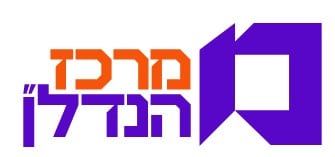
Nadlan Center is Israel’s leading real estate news and knowledge platform in Hebrew, created for industry professionals. Founded by experts in the field, it delivers in-depth, up-to-date coverage on urban renewal, planning and construction, taxation, and housing policy — tailored to the needs of developers, investors, planners, and financiers. In addition to its widely read news content, Nadlan Center hosts major industry events, professional conferences, and training programs that support the growth and development of the Israeli real estate sector.
Learn more: https://www.nadlancenter.co.il
